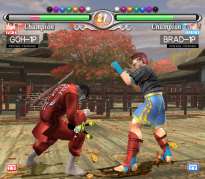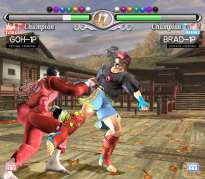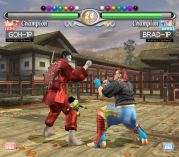While
Sega's first edition of Virtua Fighter 4 did an excellent job bringing the series to the PS2, it suffered from choppy,
jagged graphics that left many players disappointed. Fortunately, developers AM2
have addressed these issues by releasing an update, Virtua Fighter 4 Evolution.
Released as a bargain priced Greatest Hits title, VF4 Evolution also includes
two entirely new characters, a deep Quest mode plus some cool surprises. The
question on most playersí minds is whether these changes are enough to justify
repurchasing the game again. We examine VF4 Evolution and find out.
Segaís
classic martial-arts combat series Virtua Fighter has always been seen as the
gold standard in fighting games thanks to its deep, realistic moves list and
perfect controls. Up to last year, VF was always synonymous with Sega platforms,
but it made a welcome debut on the PS2, though not without a few glitches. The
graphics suffered a bit from the jaggies that plagued early PS2 releases, but
the solid gameplay and deep fighting mechanics shined through these problems.
Apparently, not satisfied with that state of affairs, AM2 has released an
updated version of the game, VF 4 Evolution. The new installment features vastly
improved graphics that lend the entire game a much smoother appearance. This is
immediately evident in the backgrounds, which have been revamped and seem
brighter, crisper, and much more alive. Character animations have also benefited
from the upgrades and donít shimmer nearly as much as before, giving them a
much more realistic appearance. In addition to the older stages, several new
areas have been included, with beautiful light-sourcing and weather effects that
make for some beautiful fighting environments. Thereís quite a lot of variety
in the locales which range from temples, to mountains and city streets, with
some taking place in open areas while others take place in caged areas that
leave you no room to escape while eliminating those annoyingly cheap ring-outs.
 While the graphics are the most immediately noticeable change, VF4 Evolutionís
tweaks are more than skin deep and implements some additions and changes that
enhance the gameplay. These are two entirely new characters, a trained assassin
named Goh and Brad, an Italian kick-boxer. Goh brings devastating Judo
techniques to the fight while Brad can inflict devastating damage with his feet.
These new additions give you 15 playable characters to choose from, and their
unique fighting styles add depth to VF4. They fit in well with the other
characters, giving the gameplay a consistent feel no matter which character you
play. The deep play mechanics, balanced abilities and strategic battles that
make the series so addictive are evident in this release as well. However, the
moves in Evolutionís harder levels are modeled after real-world players from
Japanese arcades and are quite aggressive, making for some truly competitive
matches. Players whoíve already mastered a character in VF4 can breathe a sigh
of relief because they wonít have to relearn the older characters because
their move lists are mostly unchanged.
While the graphics are the most immediately noticeable change, VF4 Evolutionís
tweaks are more than skin deep and implements some additions and changes that
enhance the gameplay. These are two entirely new characters, a trained assassin
named Goh and Brad, an Italian kick-boxer. Goh brings devastating Judo
techniques to the fight while Brad can inflict devastating damage with his feet.
These new additions give you 15 playable characters to choose from, and their
unique fighting styles add depth to VF4. They fit in well with the other
characters, giving the gameplay a consistent feel no matter which character you
play. The deep play mechanics, balanced abilities and strategic battles that
make the series so addictive are evident in this release as well. However, the
moves in Evolutionís harder levels are modeled after real-world players from
Japanese arcades and are quite aggressive, making for some truly competitive
matches. Players whoíve already mastered a character in VF4 can breathe a sigh
of relief because they wonít have to relearn the older characters because
their move lists are mostly unchanged.
Even
though veteran players have a distinct advantage over VF virgins, those who
havenít played any of the VF titles to date can use the extensive training
mode to learn the moves and techniques theyíll need to win. Your first step is
to train using the Command mode features, which allows you to perform moves as
they appear on screen, watch replays and input settings that will help you in
different situations. Once you have gone through these modes, advanced players
can undertake structured training in the Trial Mode, where you can practice the
missions that appear in the arcade mode. Like the last game, VF 4 Evolutionís
training mode makes learning the techniques and skills easy thanks to an
intuitive interface and progressive structure. This makes what could have been
an intimidating experience on thatís surprisingly accessible. Once you have
learned the basic techniques, or polished your more advanced skills, youíll
discover a game with unparalleled depth and nuance.
 As
in previous VF titles, Evolutionís control system is deceptively simple, with
a straightforward three-button configuration used to block, punch and, kick.
Players can also jump and dodge out of the way of attacks using the d-pad or
joystick controller. Another effective move is to grab your opponent and hit
them while theyíre vulnerable. However, players can recover from attacks by
counter-attacking as they get up from the ground. In addition, players can
assign the shift buttons to press the kick and punch buttons simultaneously. The
technique and sophistication of VF4 lies in chaining moves together, blocking
attacks and, being able to perform special attacks at just the right moment,
which is a matter of getting the timing down more than anything else. While the
AI opponents can be aggressive their moves become predictable after awhile.
However, Sega AM2 has implemeneted special routines and techniques that recreate
the tactics that real-world arcade players use, making for some intense battles.
The key to the gameís appeal and longevity over the years is how well it
integrates different fighting styles together to make for a seamless experience.
Another factor has to lie in the flexibility of attacks and individual style of
play that allows players to truly
make the game their own. While the simple control interface makes the game
accessible immediately, truly mastering the gameplay requires a great deal of
persistence and patience. Putting in the effort is satisfying because VF4
Evolution rewards players with balanced gameplay that emphasizes skill over
flash, since smart players can counter the gimmicky moves and defeat turtling
(i.e. cowardly) gameplay with little problem. Once again, the nearly perfect
character balance, flawless controls and strategic elements that make VF stand
head and shoulders above its competitors shine brightly in this installment.
As
in previous VF titles, Evolutionís control system is deceptively simple, with
a straightforward three-button configuration used to block, punch and, kick.
Players can also jump and dodge out of the way of attacks using the d-pad or
joystick controller. Another effective move is to grab your opponent and hit
them while theyíre vulnerable. However, players can recover from attacks by
counter-attacking as they get up from the ground. In addition, players can
assign the shift buttons to press the kick and punch buttons simultaneously. The
technique and sophistication of VF4 lies in chaining moves together, blocking
attacks and, being able to perform special attacks at just the right moment,
which is a matter of getting the timing down more than anything else. While the
AI opponents can be aggressive their moves become predictable after awhile.
However, Sega AM2 has implemeneted special routines and techniques that recreate
the tactics that real-world arcade players use, making for some intense battles.
The key to the gameís appeal and longevity over the years is how well it
integrates different fighting styles together to make for a seamless experience.
Another factor has to lie in the flexibility of attacks and individual style of
play that allows players to truly
make the game their own. While the simple control interface makes the game
accessible immediately, truly mastering the gameplay requires a great deal of
persistence and patience. Putting in the effort is satisfying because VF4
Evolution rewards players with balanced gameplay that emphasizes skill over
flash, since smart players can counter the gimmicky moves and defeat turtling
(i.e. cowardly) gameplay with little problem. Once again, the nearly perfect
character balance, flawless controls and strategic elements that make VF stand
head and shoulders above its competitors shine brightly in this installment.
The
game includes several modes of play which add depth to the game. Depending on
which mode you choose, you can earn money or prizes, which can then be used to
enhance your characterís appearance with extra items such as sunglasses and
extra oufits. Other extras include wallpapers and movies that can be unlocked.
You can spend a lot of time on these because, Evolution includes more than twice
as many of these as VF4 did with a whopping 1,500 different bonus items in all.
The standard
Arcade
mode plays just as it sounds, with players earning points
and prizes for successfully battling opponents. To reduce redundancy in the
Arcade
mode, it includes
Mission
and prize rounds where you can
earn bonuses and increase your fighterís ranking. While youíll face many
standard rounds, there are also mission rounds, where you have to successfully
complete to earn rewards. The win conditions range from simple to complex and
difficult. These include defeating an opponent before the time runs out, while
other missions require you to block more moves than your foe, or increase the
damage you receive when your character falls on the ground. Players can also
face-off against a human opponent in the Versus mode, which is fairly
self-explanatory. As an extra added bonus included to celebrate the seriesí 10th
Anniversary, Sega has also included a special retro mode. This is a cool
addition where you can play the original game complete with the classic
polygonal character models, music and stages. This is a clever, nostalgic
addition that allows you to play as all of the 15 characters, even the newer
ones, with most of their move sets intact. This is a nice treat, especially for
PS fans who never got a Saturn or Dreamcast and havenít played any of the
older games.
 However,
the most interesting and deepest part of VF4 Evolution lies in its Quest Mode,
which provides quite a challenge. Replacing the Kumite mode from the first VF4
installment, this deep mode allows you to compete in the ultimate arcade
tournament against a series of opponents. You begin your quest in local arcades,
where you have to beat a large number of computer-controlled players in order to
qualify for the tournament. In addition to earning prize money and extras, you
also build your rankings by defeating opponents in designated rounds. There are
prize rounds here as well, which makes the battles a lot more interesting. In
addition to the standard fighting circuit, players can choose to participate in
underground matches, which have interesting rules variations, such as caged
matches, getting through an entire round without taking hits and other
requirements. Quest mode definitely adds a lot of depth to an already deep game.
Add in a fighting system thatís unmatched in depth and sophistication, and you
have an outstanding title that will keep you challenged no matter what your
skill level is.
However,
the most interesting and deepest part of VF4 Evolution lies in its Quest Mode,
which provides quite a challenge. Replacing the Kumite mode from the first VF4
installment, this deep mode allows you to compete in the ultimate arcade
tournament against a series of opponents. You begin your quest in local arcades,
where you have to beat a large number of computer-controlled players in order to
qualify for the tournament. In addition to earning prize money and extras, you
also build your rankings by defeating opponents in designated rounds. There are
prize rounds here as well, which makes the battles a lot more interesting. In
addition to the standard fighting circuit, players can choose to participate in
underground matches, which have interesting rules variations, such as caged
matches, getting through an entire round without taking hits and other
requirements. Quest mode definitely adds a lot of depth to an already deep game.
Add in a fighting system thatís unmatched in depth and sophistication, and you
have an outstanding title that will keep you challenged no matter what your
skill level is.
While
thereís little doubt that, from a gameplay standpoint, the Virtua Fighter
franchise remains in top-form with this release, the biggest problem with VF4
Evolution is an obvious one. Itís basically an enhanced version of a game that
came out a little over a year ago. While this complaint is valid, its not an
entirely accurate portrayal of whatís actually being offered. Gamers
displeasure would have been justified if Sega had charged full price for
prettier graphics, but this isnít the case. At a bargain basement price, the
game offers a lot of value for the money. In fact, thereís more here more than
youíd reasonably expect there to be. The improved graphics alone wouldnít
have justified a repurchase for those who already had VF4, but Evolutionís
additional characters, addictive Quest mode and super-cool Retro mode are more
than worth the price of admission. Fans of the first game should appreciate the
additions, while thereís never been a better time those whoíve never played
the game to jump right in.
- Michael Palisano

